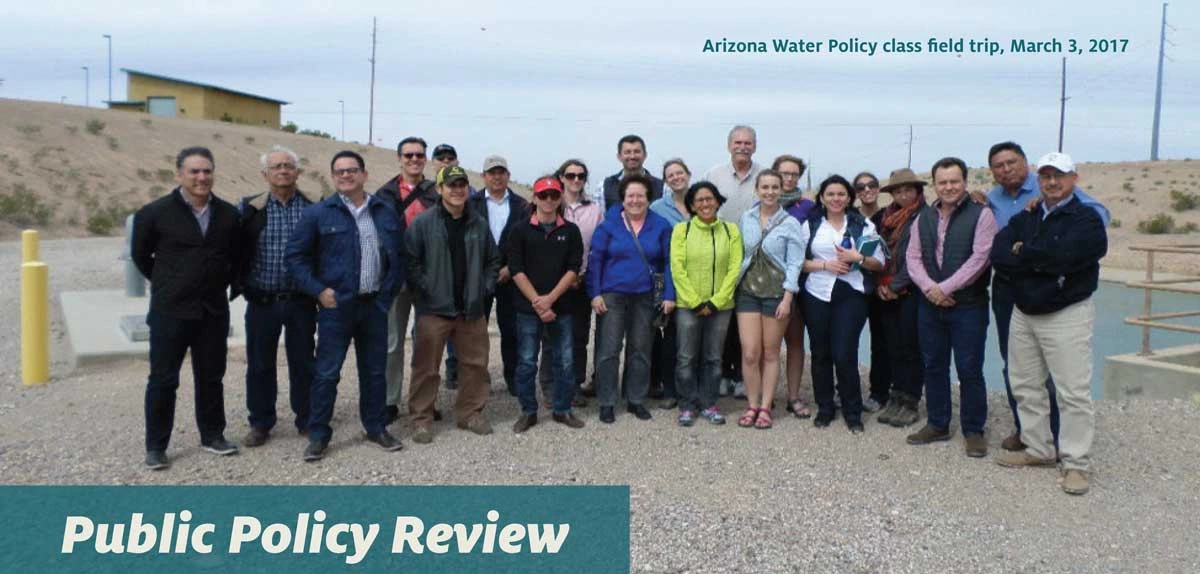Public Policy Review

Spring semester is always a busy time of year. I teach my graduate Arizona Water Policy class and convene a seminar class for the Master’s program in Water, Society, and Policy. Students are completing theses, projects, and examinations as they ready for graduation. The Water Resources Research Center recently held its Annual Conference, which it has done every year since 2003.
While I am confident that students enjoy their classroom learning opportunities, getting out in the field is – at least for me – a course highlight. Early in March, visitors from Sonora, Mexico joined my class for our annual field trip to Tucson Water’s recharge and wetlands sites and Central Arizona Project’s Twin Peaks Pumping Plant, with a great outdoor lunch at the White Stallion Ranch in Marana hosted by BKW Farms.
The WRRC’s Annual Conference provides another mechanism for exploration. We were pleased with and thankful for the strong interest in this year’s topic, “Irrigated Agriculture in Arizona – A Fresh Perspective”, and the contributions of all of our speakers, moderators, sponsors, and attendees. Although we could not take well over 300 people into the field to learn about irrigation practices and cropping patterns in Arizona, we sincerely hope that attendees at our March 28, 2017 conference found the presentations and commentary we brought to them informative and interesting. The WRRC’s Annual Conference is designed to address a topic of statewide importance and bring together participants from throughout Arizona and beyond to share information and to learn. This year’s participants came from about 35 Arizona communities and from eight other states in the US, Washington, DC and Sonora, Mexico. The conference benefitted tremendously from the input and assistance of an engaged conference advisory committee. For attendees and non-attendees, we have posted the presentation videos and, when available, power point slides. Please take a look. And please mark your calendars for next year’s conference! Our 2018 Annual Conference on “The Business of Water” will be held on March 28 at the University of Arizona Memorial Student Union. We received very positive feedback on this topic, which is broadly construed to include water financing, water rates, public-private partnerships, water commodification and marketing, and more. Let me know your thoughts about topics and perspectives to include by emailing me at smegdal@email. arizona.edu.
This has been a busy semester for research project work as well. In particular, work continues on various aspects of the binational Transboundary Aquifer Assessment Program (TAAP). Late in 2016 we announced the official release of the Binational Study of the Transboundary San Pedro Aquifer, a key product of the binational TAAP. The International Boundary and Water Commission posted the peer-reviewed report in English (https://www.ibwc.gov/Files/San_Pedro_Binational_Report_En_01122017.pdf) and Spanish (https://www.ibwc.gov/Files/San_Pedro_Binational_Report_ ESP_Final_2016.pdf). We continue to work on completing ;a similar report for the transboundary Santa Cruz aquifer. WRRC research analyst Jacob Petersen-Perlman and I have written an invited book chapter explaining how the TAAP effort is consistent with the information sharing goals of the United Nations International Law Commission’s Draft Articles on the Law of Transboundary Aquifers. Graduate student Elia Tapia, whose excellent translation and GIS mapping skills are reflected in the published San Pedro Study, is working on expanding our understanding of the relationship between precipitation and groundwater utilization patterns at the border. We will soon release a synopsis of the San Pedro Study in both English and Spanish and our binational team will speak to the many facets of this study effort at the May international World Water Congress in Cancún, Mexico and the June national conference of the Universities Council on Water Resources in Ft. Collins, Colorado. At the World Water Congress, a multi-part special session considering shared waters of North America will feature participants from all regions involved in TAAP. They will speak to the program’s scientific and modeling accomplishments, along with some of the institutional and legal considerations. There I will discuss the importance of the 2009 Joint Report of the Principle Engineers Regarding the Joint Cooperative Process United States-Mexico for the Transboundary Aquifer Assessment Program, which has guided this important binational collaborative effort. The robust cooperative process for the Arizona-Sonora portion of the TAAP involves the U.S. and Mexican Sections of the International Boundary and Water Commission, U.S. Geological Survey, Comisión Nacional del Agua (CONAGUA), University of Sonora, and University of Arizona. It can serve as a model for federal-university partnerships and binational studies that go well beyond aquifer assessment.
More information about the TAAP, particularly the Arizona-Sonora portion of the program, can be found within our site.
I look forward to the culmination of Spring semester activities. And of course, the work will continue, which I look forward to as well!

